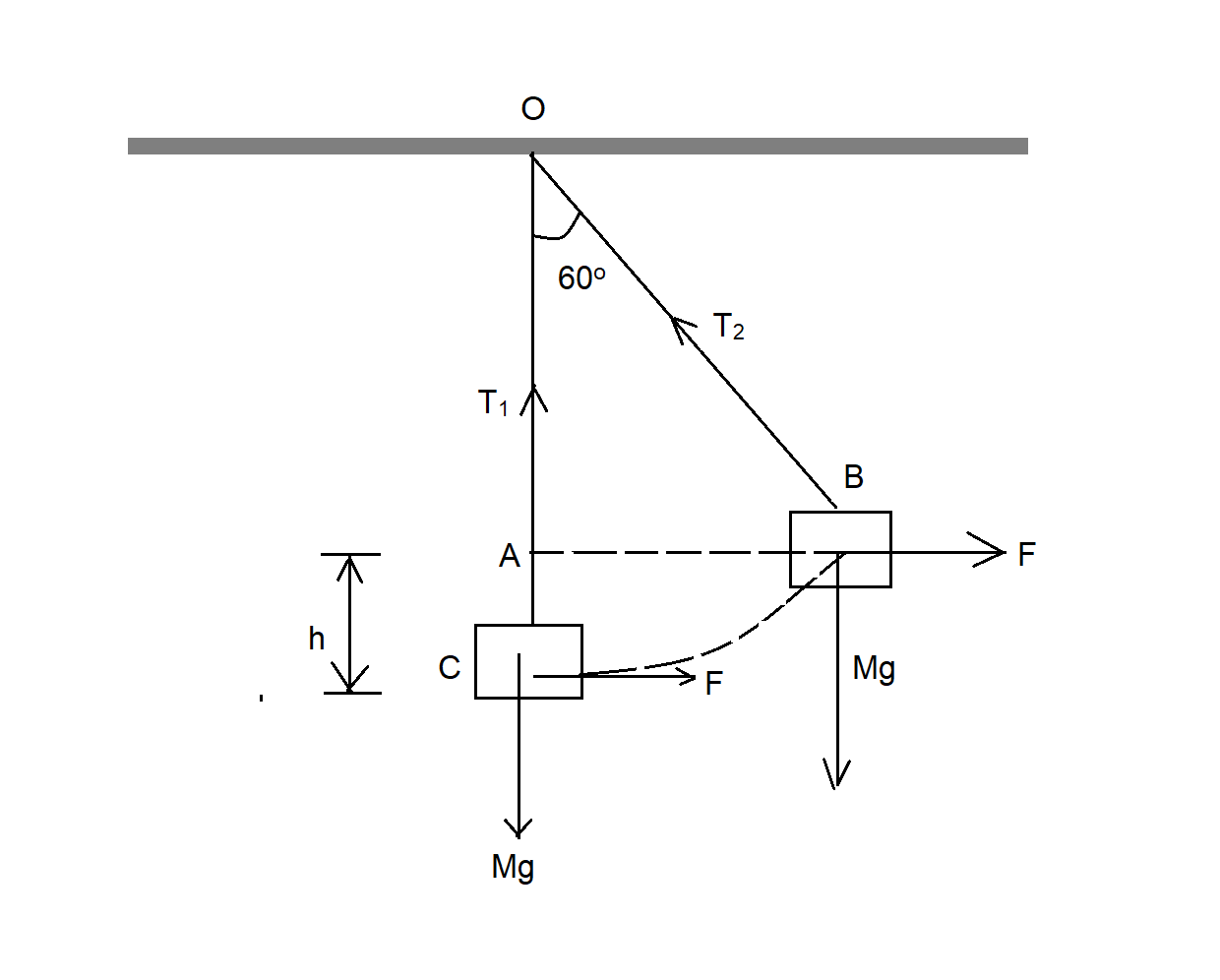
A mass $M Kg$ is suspended by a weightless string. The horizontal force required to hold the mass at ${60^o}$ with the vertical is
(A) $Mg$
(B) $Mg\sqrt 3 $
(C) $Mg\left( {\sqrt 3 + 1} \right)$
(D) $\dfrac{{Mg}}{{\sqrt 3 }}$
Answer
142.2k+ views
Hint We are given with a body suspended by a weightless string and are asked to find the horizontal force required to hold the mass at the given angle. Thus, we will use the work energy theorem to solve the given problem.
Formulae Used:
$W = \Delta T$
Where,$W$ is the work done by the body and$\Delta {\rm T}$ is the change in kinetic energy.
Complete step by step solution

Here,
The total work done is$W = {W_{{T_1}}} + {W_{{T_2}}}$
Where,$W$ is the net work done,${W_{{T_1}}}$ is the work done by the tension${T_1}$ and${W_{{T_2}}}$ is the work done by the tension${T_2}$.
Now,
As the string is the same, then the tension will remain constant.
Thus,
${T_1} = {T_2} = T$
Now,
As per the diagram,
$T = Mg$
Also,
As the horizontal force acting on the body is constant and thus the velocity of the body remains constant and thus, the change in the kinetic energy of the body is$0$.
Thus,
${W_{{T_1}}} + {W_{{T_2}}} = \Delta T$
Then,
${W_{{T_1}}} + {W_{{T_2}}} = 0$
Further, we get
$F \times AC + {F_H} \times AB = 0$
Now,
The force on the body is$T$.
Then, we get
${F_H} = - F\left( {\dfrac{{AC}}{{AB}}} \right)$
Further, we get
${F_H} = \left( { - Mg} \right)\left( {\dfrac{{ - h}}{{AB}}} \right)$
Then, we get
${F_H} = \left( { - Mg} \right)\left( { - \tan {{60}^o}} \right)$
Then, we get
${F_H} = Mg\sqrt 3 $
Hence, The correct option is (B).
Note We calculated the answer using the work energy theorem. This is because, for the moving body, we can relate the work done and the energy of the body to a great precision.
Formulae Used:
$W = \Delta T$
Where,$W$ is the work done by the body and$\Delta {\rm T}$ is the change in kinetic energy.
Complete step by step solution

Here,
The total work done is$W = {W_{{T_1}}} + {W_{{T_2}}}$
Where,$W$ is the net work done,${W_{{T_1}}}$ is the work done by the tension${T_1}$ and${W_{{T_2}}}$ is the work done by the tension${T_2}$.
Now,
As the string is the same, then the tension will remain constant.
Thus,
${T_1} = {T_2} = T$
Now,
As per the diagram,
$T = Mg$
Also,
As the horizontal force acting on the body is constant and thus the velocity of the body remains constant and thus, the change in the kinetic energy of the body is$0$.
Thus,
${W_{{T_1}}} + {W_{{T_2}}} = \Delta T$
Then,
${W_{{T_1}}} + {W_{{T_2}}} = 0$
Further, we get
$F \times AC + {F_H} \times AB = 0$
Now,
The force on the body is$T$.
Then, we get
${F_H} = - F\left( {\dfrac{{AC}}{{AB}}} \right)$
Further, we get
${F_H} = \left( { - Mg} \right)\left( {\dfrac{{ - h}}{{AB}}} \right)$
Then, we get
${F_H} = \left( { - Mg} \right)\left( { - \tan {{60}^o}} \right)$
Then, we get
${F_H} = Mg\sqrt 3 $
Hence, The correct option is (B).
Note We calculated the answer using the work energy theorem. This is because, for the moving body, we can relate the work done and the energy of the body to a great precision.
Recently Updated Pages
How to find Oxidation Number - Important Concepts for JEE

How Electromagnetic Waves are Formed - Important Concepts for JEE

Electrical Resistance - Important Concepts and Tips for JEE

Average Atomic Mass - Important Concepts and Tips for JEE

Chemical Equation - Important Concepts and Tips for JEE

Concept of CP and CV of Gas - Important Concepts and Tips for JEE

Trending doubts
JEE Main 2025 Session 2: Application Form (Out), Exam Dates (Released), Eligibility, & More

JEE Main Exam Marking Scheme: Detailed Breakdown of Marks and Negative Marking

JEE Main 2025: Derivation of Equation of Trajectory in Physics

Electric Field Due to Uniformly Charged Ring for JEE Main 2025 - Formula and Derivation

Learn About Angle Of Deviation In Prism: JEE Main Physics 2025

Degree of Dissociation and Its Formula With Solved Example for JEE

Other Pages
Units and Measurements Class 11 Notes: CBSE Physics Chapter 1

JEE Advanced Marks vs Ranks 2025: Understanding Category-wise Qualifying Marks and Previous Year Cut-offs

NCERT Solutions for Class 11 Physics Chapter 1 Units and Measurements

JEE Advanced 2025: Dates, Registration, Syllabus, Eligibility Criteria and More

Motion in a Straight Line Class 11 Notes: CBSE Physics Chapter 2

JEE Advanced Weightage 2025 Chapter-Wise for Physics, Maths and Chemistry




